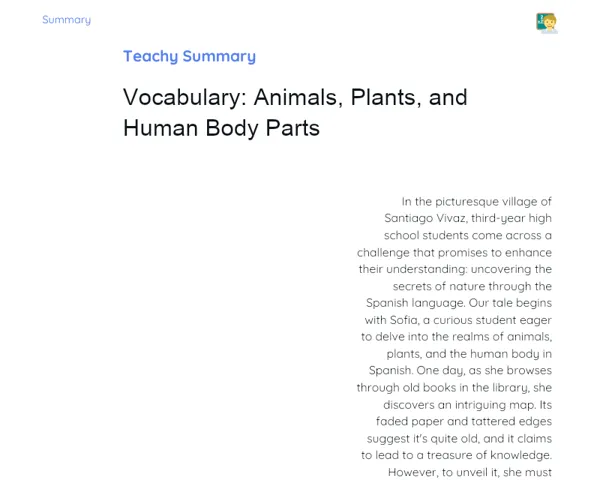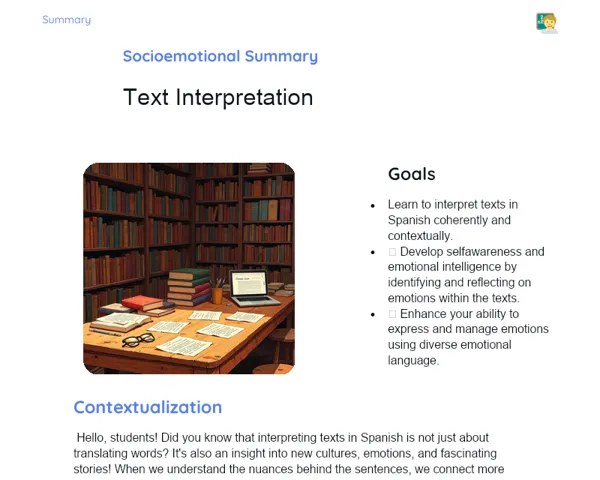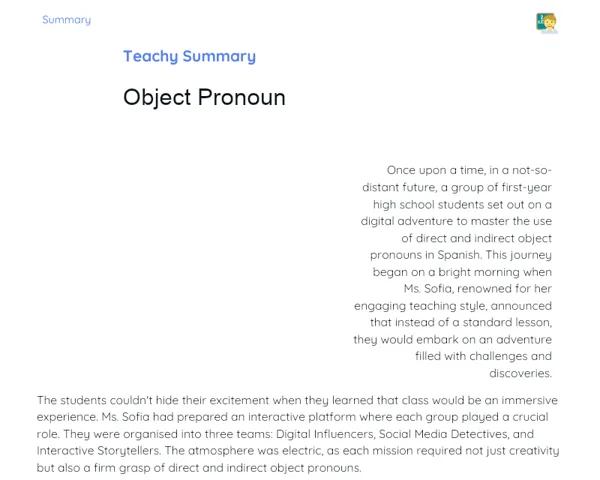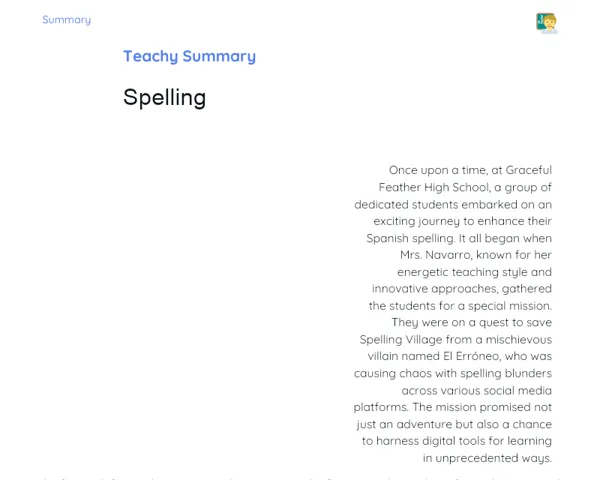Summary Tradisional | Verbs: Like
Contextualization
The Spanish verb 'gustar' is a key expression used to convey likes, preferences, and interests. Unlike many verbs in Portuguese, 'gustar' follows a unique structure which may initially seem challenging to learners. In Spanish, you don’t simply say 'I like'; instead, the phrase is closer to 'me agrada', prompting a different way of thinking when constructing sentences. This grammatical feature is essential for anyone aiming to communicate effectively in Spanish, be it in casual chit-chat or more formal settings. Moreover, understanding 'gustar' goes beyond mere grammar; it opens a window into cultural nuances. In many Hispanic cultures, expressing preferences is a natural part of everyday interactions. Thus, using 'gustar' correctly not only improves communication but also deepens one’s appreciation of these cultural subtleties. For any Spanish learner in our diverse classroom context, mastering this verb is crucial to gaining fluency and a richer understanding of the language.
To Remember!
Conjugation of the Verb 'Gustar'
The verb 'gustar' behaves differently from regular verbs because its conjugation is determined by the object rather than the subject. For instance, in the sentence 'Me gusta el libro' (I like the book), the verb 'gusta' matches 'libro', which is singular. In 'Me gustan los libros' (I like the books), 'gustan' agrees with 'libros', which is plural. This reversal in conventional thinking about verb conjugation can be a bit tricky for learners. Remember, with 'gustar', it’s the object that determines the verb form, not the subject. Thus, examples like 'Me gusta la pizza' and 'Me gustan las pizzas' clearly illustrate this rule. It is also useful to note that 'gustar' can combine with infinitives when expressing a liking for certain actions, such as in 'Me gusta cantar' (I like to sing) or 'Me gusta bailar' (I like to dance), where the infinitive is treated as a singular noun.
-
The verb 'gustar' adjusts its form to agree with the direct object of the sentence.
-
Use 'gusta' with singular nouns and with infinitives.
-
Use 'gustan' when referring to plural nouns.
Use of Indirect Object Pronouns
Indirect object pronouns (me, te, le, nos, os, les) are indispensable when using 'gustar' correctly. These pronouns indicate who is receiving the feeling of pleasure. For example, in 'A mí me gusta el libro' (I like the book), the pronoun 'me' shows that the book pleases me. Similarly, in 'A ellos les gusta la música' (They like music), 'les' denotes that it pleases them. While the sentence structure can sometimes be rearranged, the indirect object pronoun always comes before the verb 'gustar'. Although it’s common to include a prepositional phrase (like 'A mí', 'A ti', 'A él/ella/usted', etc.) for emphasis or clarity, it isn’t always necessary. For example, simply saying 'Me gusta el libro' is perfectly acceptable. Regular practice with these pronouns will help make them an automatic part of forming correct sentences with 'gustar'.
-
Indirect object pronouns are essential for correct usage of 'gustar'.
-
They always precede the verb 'gustar'.
-
They can be paired with a prepositional phrase for additional clarity or emphasis.
Structure of a Sentence with 'Gustar'
A typical sentence using 'gustar' features a prepositional phrase, an indirect object pronoun, the verb 'gustar', and finally the object that is liked. For example, in 'A nosotros nos gusta la película' (We like the movie), 'A nosotros' is the prepositional phrase, 'nos' is the indirect object pronoun, 'gusta' is the conjugated form of the verb, and 'la película' is the object of affection. Although the order can be rearranged for emphasis or stylistic reasons – as in 'La película nos gusta a nosotros' – the conventional order tends to be more straightforward, especially for beginners. Starting with simple examples like 'Me gusta el chocolate', and gradually progressing to more complex sentences such as 'A mi hermana le gustan los gatos', will help students build confidence and fluency.
-
The standard construction includes a prepositional phrase, an indirect object pronoun, the verb 'gustar', and the object.
-
The order can be altered for emphasis or stylistic effect.
-
Beginners benefit from practicing with simple examples before moving on to more complex constructions.
Cultural Contextualization
Learning how to use the verb 'gustar' correctly is not merely about grammar—it has a cultural dimension as well. In many Hispanic settings, sharing what one likes or prefers is a key part of social interaction. Using 'gustar' correctly not only enables clearer communication but also helps one appreciate the cultural nuances that underlie everyday conversations. For example, asking '¿Qué te gusta hacer?' (What do you like to do?) is a common way to start a conversation, and being able to answer it properly helps build bonds and enhance intercultural communication. Furthermore, expressing likes in the right way can prevent misunderstandings and make interactions smoother. Integrating the language in various cultural contexts—be it through music, films, or regular day-to-day conversations—allows learners to see the practical side of grammar and makes the learning experience more engaging and meaningful.
-
Expressing likes is a central part of social interactions in Hispanic cultures.
-
Correct use of 'gustar' improves intercultural communication.
-
Engaging with various cultural contexts adds depth to language learning.
Key Terms
-
Gustar: A verb used to express likes and preferences in Spanish.
-
Conjugation: Modifying the verb based on the object in the sentence.
-
Indirect Object Pronouns: Pronouns that indicate to whom or what something appeals.
-
Sentence Structure: The typical organization of elements in a sentence using 'gustar'.
Important Conclusions
The use of 'gustar' is essential for expressing likes, preferences, and interests in Spanish. Unlike some other languages, in Spanish the verb is conjugated based on the object rather than the subject, making it important to grasp this distinct approach for effective communication. The proper use of indirect object pronouns is key to forming clear and accurate sentences, as they show who is pleased by the object in question. The typical sentence structure—starting with a prepositional phrase, followed by the indirect object pronoun, the verb 'gustar', and finally the object—underscores the unique nature of this construction. Beyond grammar, an understanding of the cultural context in which 'gustar' is used enriches social interactions in Hispanic environments. For students aiming for fluency, mastering 'gustar' is not just a grammatical exercise, but also an insight into the rich cultural tapestry that underpins everyday Spanish conversations. We encourage all learners to practice regularly and explore diverse contexts where 'gustar' appears to build both competence and confidence in the language.
Study Tips
-
Regularly practice conjugating 'gustar' with various pronouns and objects to build confidence.
-
Watch Spanish films, TV shows, or listen to Spanish music to observe how 'gustar' is used in different scenarios.
-
Read Spanish texts such as articles or books, and highlight sentences containing 'gustar' to better understand its practical application.



